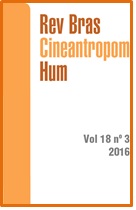Desempenho em 200 m nado crawl: índice de coordenação, tempo propulsivo e cinemática de nado
DOI:
https://doi.org/10.1590/1980-0037.2016v18n3p311Resumo
O objetivo deste estudo foi comparar índice de coordenação, tempo propulsivo, duração das fases da braçada e parâmetros cinemáticos ao longo de 200 m nado crawl. Variáveis foram comparadas entre os quatro trechos de 50 m (T1 a T4) em quinze nadadores competitivos (idade: 21,1 ± 7,1 anos; estatura: 180,1 ± 6,1 cm; envergadura: 187,3 ± 8,1 cm; massa corporal: 72,1 ± 10,1 kg; melhor desempenho na prova: 77,5 ± 4,7% do recorde mundial). Obtiveram-se os dados com duas câmeras de vídeo (60 Hz - acopladas a um carrinho sobre trilhos na lateral da piscina), para imagens simultâneas do plano sagital do nadador: abaixo da linha da água e acima da linha da água. Frequência média de ciclos, comprimento de braçada (assumida como a distância média percorrida pelo corpo a cada ciclo) e velocidade média de nado foram obtidos com cronometragem manual. Ao longo dos 200 m, o índice de coordenação não se alterou (p > 0,05), mas houve incremento da frequência de ciclos (p < 0,05) e redução da distância percorrida por ciclo (p < 0,05). Entre T1 e T2, houve incremento do tempo propulsivo (p < 0,05) e entre T1 e T4, da duração da fase de puxada (p < 0,05). Velocidade de nado diminuiu apenas entre T1 e T2 (p < 0,05). Ao longo de 200 m nado crawl, nadadores bem treinados incrementam tempo propulsivo, duração da fase de puxada e frequência de ciclos de braçadas, tais mudanças podem ser devidas à tentativa de manutenção da velocidade ao longo dos 200 m.
Downloads
Publicado
Edição
Seção
Licença

Direitos Autorais para artigos publicados nesta revista são do autor, com direitos de primeira publicação para a revista. Em virtude da aparecerem nesta revista de acesso público, os artigos são de uso gratuito, com atribuições próprias, em aplicações educacionais e não-comerciais, desde que seja dada a atribuição. Esta obra foi licenciada com uma Licença Creative Commons Atribuição 4.0 Internacional - CC BY


